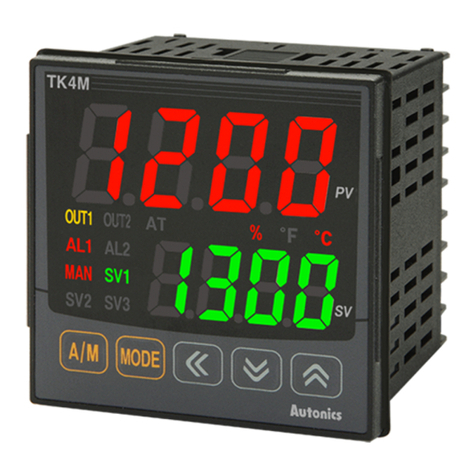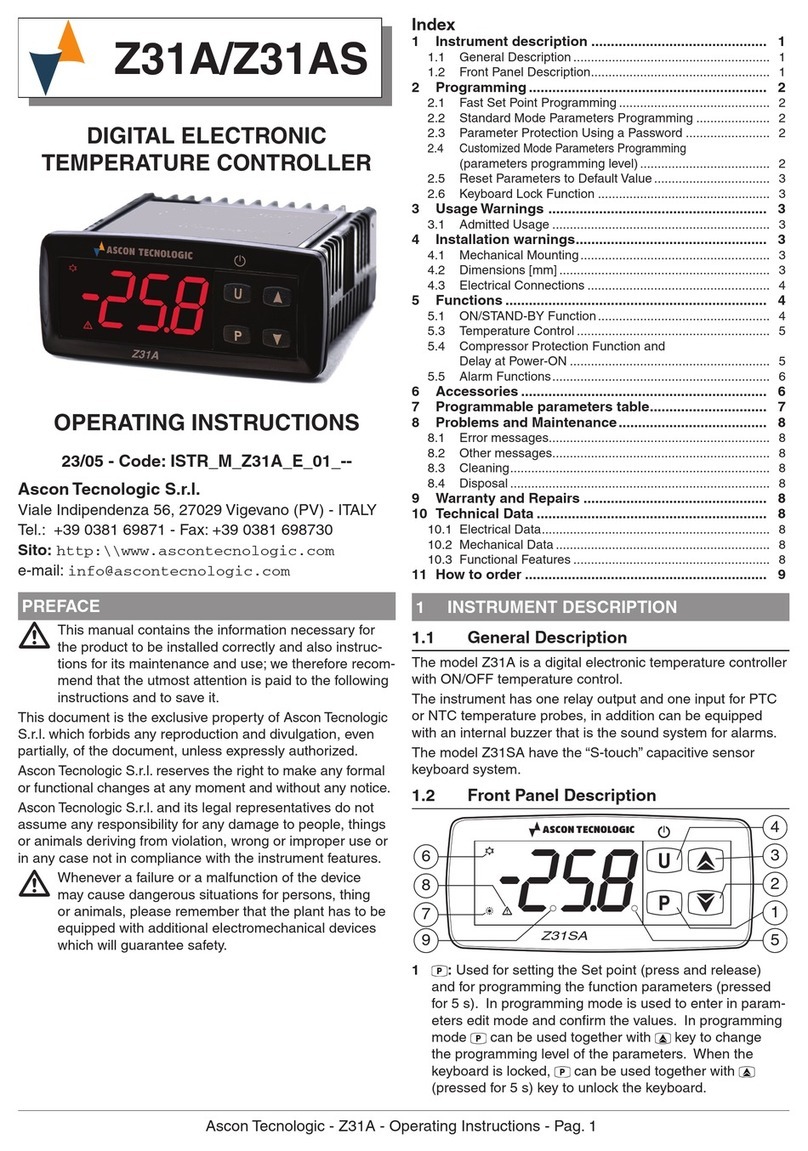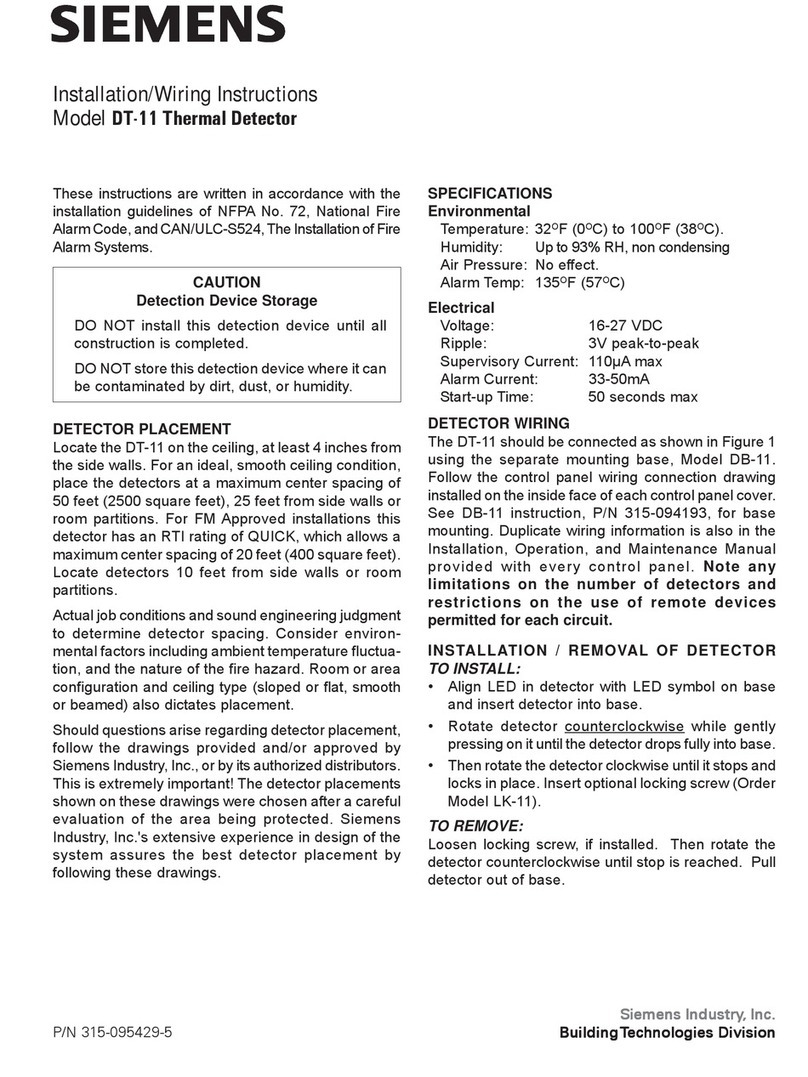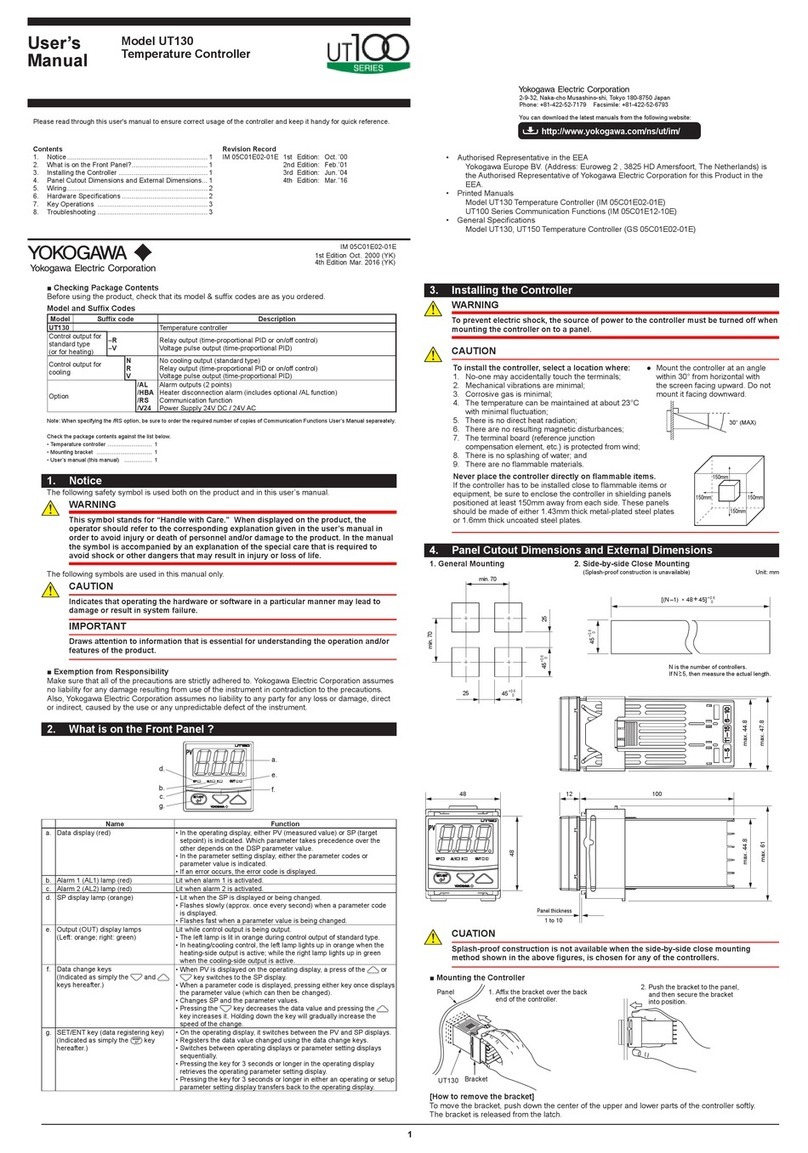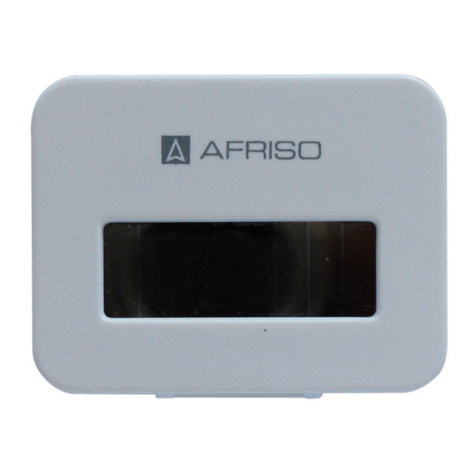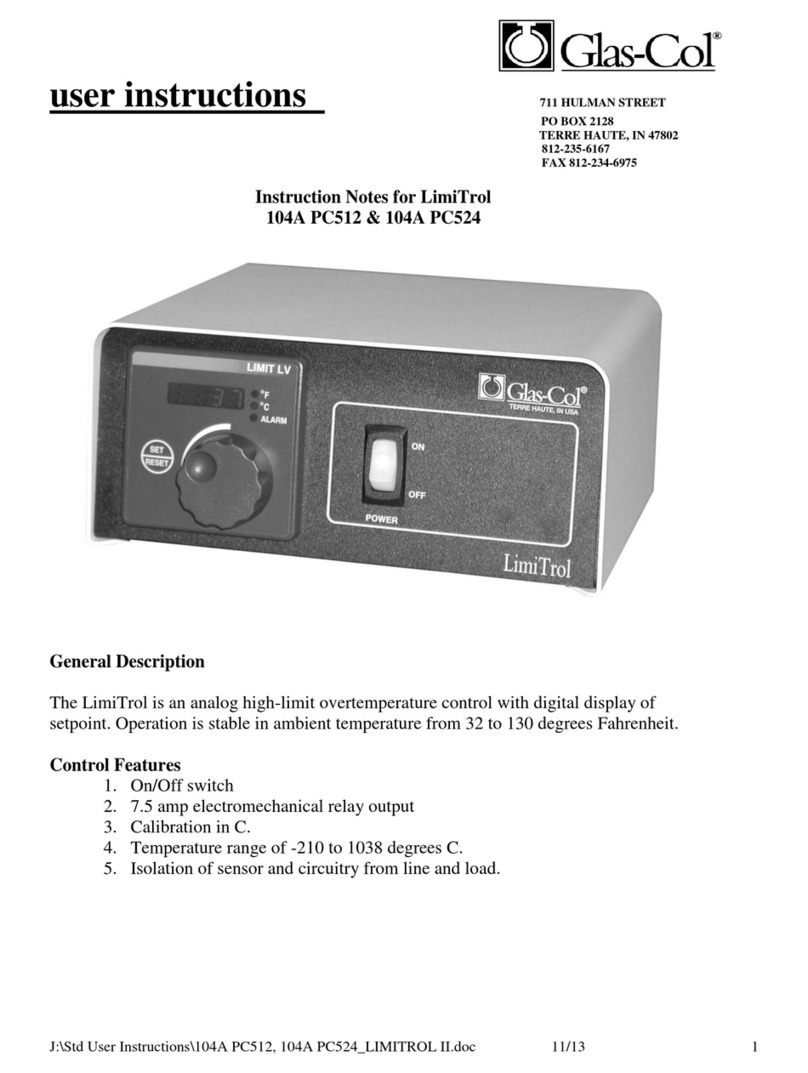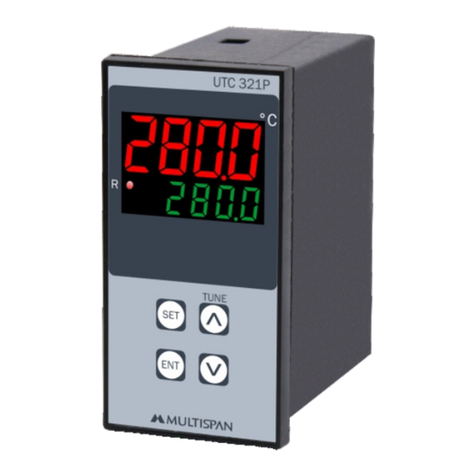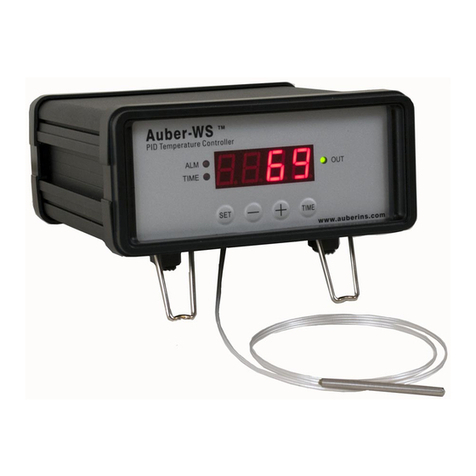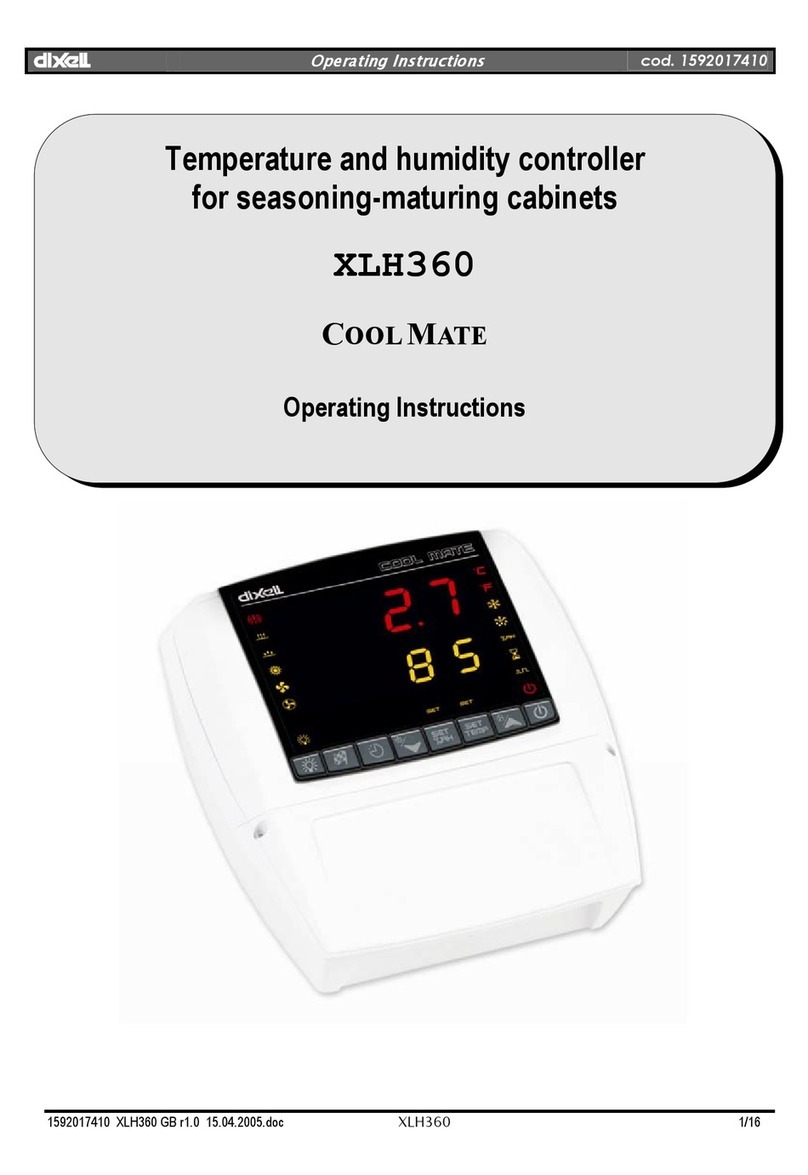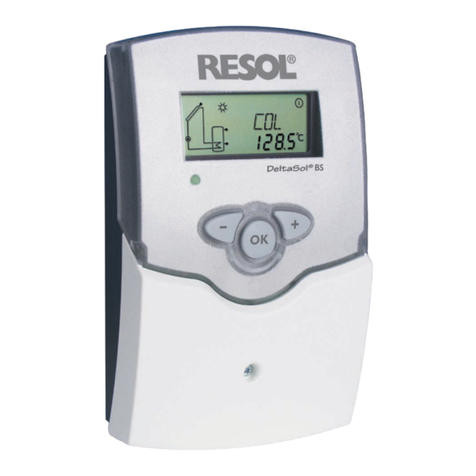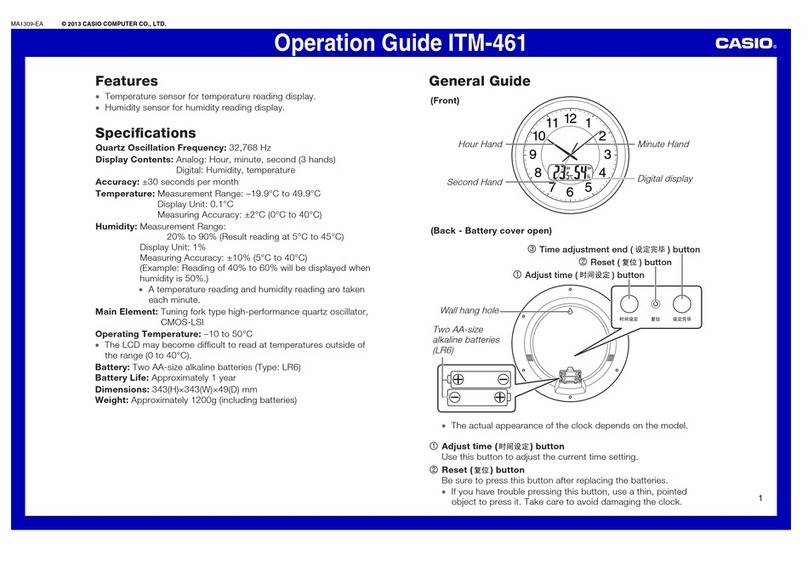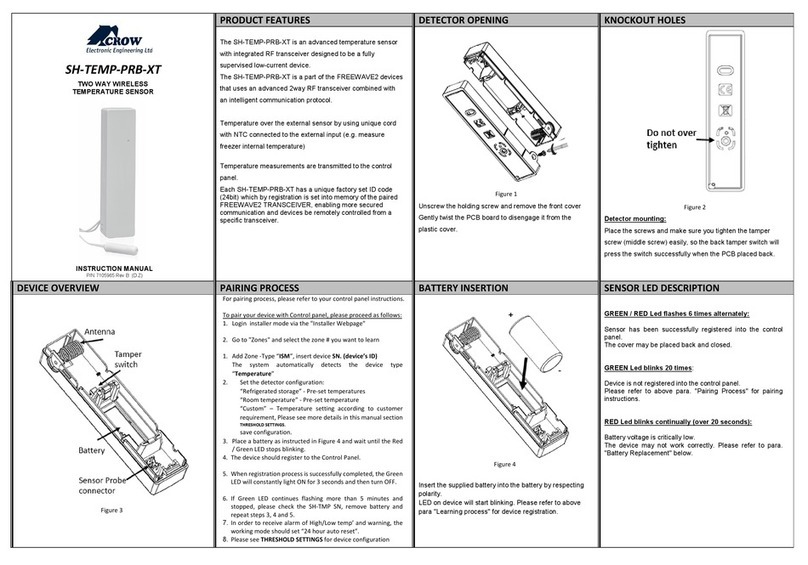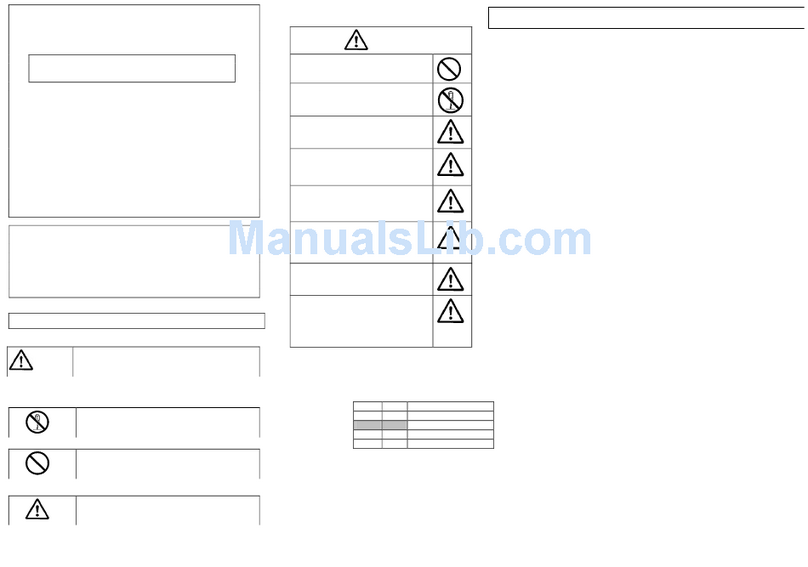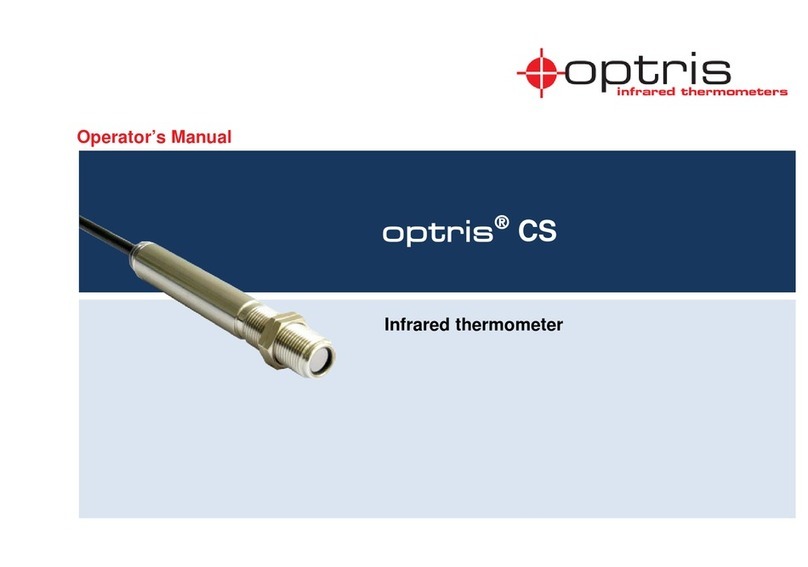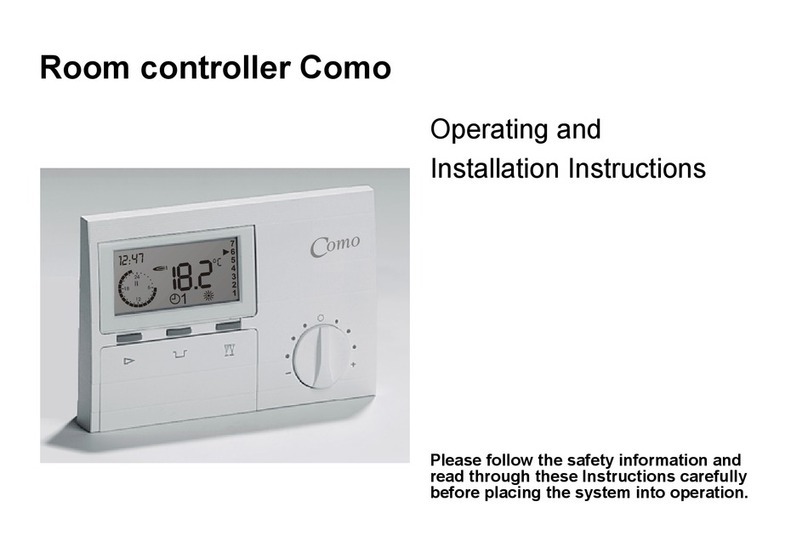elsner elektronik KNX T-AP Guide

EN
Installation and Adjustment
KNX T-AP
Temperature Sensor
Item number 70121


1 Contents
Elsner Elektronik GmbH • Sohlengrund 16 • 75395 Ostelsheim • Germany
Temperature Sensor KNX T-AP • from software version 0.2.0, ETS programme version 2.0
Version: 27.01.2020 • Errors excepted. Subject to technical changes.
1. Description ........................................................................................... 3
1.1. Deliverables .............................................................................................................. 3
1.2. Technical specifications ........................................................................................... 3
2. Installation and commissioning ........................................................... 4
2.1. Installation notes ...................................................................................................... 4
2.2. Location ..................................................................................................................... 5
2.3. Mounting and connection ....................................................................................... 5
2.3.1. Layout ............................................................................................................ 5
2.3.2. Connection of the sensor ............................................................................. 6
2.4. Notes on mounting and commissioning ................................................................ 6
3. Addressing of the device at the bus .................................................... 6
4. Maintenance ......................................................................................... 6
5. Transfer protocol ................................................................................. 7
5.1. List of all communication objects ........................................................................... 7
6. Setting parameters ............................................................................ 10
6.1. Behaviour on power failure/ restoration of power .............................................. 10
6.2. General settings ..................................................................................................... 10
6.3. Temperature measured value ............................................................................... 10
6.4. Temperature threshold values .............................................................................. 11
6.4.1. Temperature threshold values 1, 2, 3, 4 .................................................... 11
6.5. Temperature PI control .......................................................................................... 13
6.5.1. Heating control level 1/2 ............................................................................. 15
6.5.2. Cooling control level 1/2 ............................................................................. 17
6.6. Logic ........................................................................................................................ 21
6.6.1. AND logic 1-4 and OR logic outputs 1-4 ................................................... 21
6.6.2. AND logic connection inputs ..................................................................... 22
6.6.3. OR logic connection inputs ........................................................................ 23

2 Clarification of signs
This manual is amended periodically and will be brought into line with new software
releases. The change status (software version and date) can be found in the contents footer.
If you have a device with a later software version, please check
www.elsner-elektronik.de in the menu area "Service" to find out whether a more up-to-
date version of the manual is available.
Clarification of signs used in this manual
Installation, inspection, commissioning and troubleshooting of the device
must only be carried out by a competent electrician.
Safety advice.
Safety advice for working on electrical connections, components,
etc.
DANGER! ... indicates an immediately hazardous situation which will lead to
death or severe injuries if it is not avoided.
WARNING! ... indicates a potentially hazardous situation which may lead to
death or severe injuries if it is not avoided.
CAUTION! ... indicates a potentially hazardous situation which may lead to
trivial or minor injuries if it is not avoided.
ATTENTION! ... indicates a situation which may lead to damage to property if it is
not avoided.
ETS In the ETS tables, the parameter default settings are marked by
underlining.

3 Description
Temperature Sensor KNX T-AP • Version: 27.01.2020 • Errors excepted. Subject to technical changes.
1. Description
The Temperature Sensor KNX T-AP measures temperature in indoor and outdoor
areas. The sensor can receive an external measured value via the bus and process it
with the own data to an overall temperature (mixed value).
The KNX T-AP provides four switching outputs with adjustable threshold values as
well as additional AND and OR logic gates. The sensor has got a PI controller for heat-
ing and cooling.
Functions:
• Measurement of temperature
•Mixed value from own measured value and external value (proportions can
be set in percentage)
•PI controller for heating (one or two step) and cooling (one or two step)
•Threshold values can be adjusted per parameter or via communication
objects
•4 AND and 4 OR logic gates with each 4 inputs. Every switching incident as
well as 8 logic inputs in the form of communication objects may be used as
inputs for the logic gates. The output of each gate may optionally be configured
as 1 bit or 2 x 8 bits
Configuration is made using the KNX software ETS. The product file can be down-
loaded from the Elsner Elektronik website on www.elsner-elektronik.de in the “Ser-
vice” menu.
1.1. Deliverables
• Temperature sensor
1.2. Technical specifications
Housing Plastic material, sensor sleeve metal
Colour Grey
Mounting On-wall
Protection category IP 65
Dimensions approx. 65 × 93 × 38 (W × H × D, mm)
Weight approx. 70 g
Ambient temperature Operation -30…+85°C, Storage -55…+125°C
Operating voltage KNX bus voltage
Bus current max. 5.5 mA, max. 15 mA when programming LED is
active
Data output KNX +/- bus terminal plug
BCU type Own micro controller
PEI type 0
Group addresses max. 184

4 Installation and commissioning
Temperature Sensor KNX T-AP • Status: 27.01.2020 • Errors excepted. Subject to technical changes.
The product conforms with the provisions of EU directives.
2. Installation and commissioning
2.1. Installation notes
Installation, testing, operational start-up and troubleshooting should
only be performed by an electrician.
CAUTION!
Live voltage!
There are unprotected live components inside the device.
• National legal regulations are to be followed.
• Ensure that all lines to be assembled are free of voltage and take
precautions against accidental switching on.
• Do not use the device if it is damaged.
• Take the device or system out of service and secure it against
unintentional use, if it can be assumed, that risk-free operation is no
longer guaranteed.
The device is only to be used for its intended purpose. Any improper modification or
failure to follow the operating instructions voids any and all warranty and guarantee
claims.
After unpacking the device, check it immediately for possible mechanical damage. If it
has been damaged in transport, inform the supplier immediately.
The device may only be used as a fixed-site installation; that means only when assem-
bled and after conclusion of all installation and operational start-up tasks and only in
the surroundings designated for it.
Elsner Elektronik is not liable for any changes in norms and standards which may occur
after publication of these operating instructions.
Allocations max. 184
Communication objects 80
Measurement range
temperature
-30...+80°C
Resolution (temperature) 0.1°C
Accuracy (temperature) ±1°C at -30...+80°C

5 Installation and commissioning
Temperature Sensor KNX T-AP • Version: 27.01.2020 • Errors excepted. Subject to technical changes.
2.2. Location
The sensor is designed for surface mounting. When selecting an installation location,
please ensure that the measurement results are affected as little as possible by exter-
nal influences. Possible sources of interference include:
• Direct sunlight
• Drafts from windows and doors
• Warming or cooling of the building structure on which the sensor is mounted,
e.g. due to sunlight, heating or cold water pipes
• Connection lines which lead from warmer or colder areas to the sensor
Temperature variations from such sources of interference must be corrected in the ETS
in order to ensure the specified accuracy of the sensor (temperature offset).
For outdoor installation it must be ensured that a 60 cm gap is left below the sensor in
order to prevent it from being snowed during snowfall.
The sensor must be mounted vertically. The measurement probe and the cable outlet
must point downwards.
2.3. Mounting and connection
2.3.1. Layout
Fig. 1 Opened casing, board
1 Slot for KNX terminal +/-
2 Programming button for teaching the
instrument
3 Programming LED
4 Cable entry with threaded joint
5 Temperature sensor tip
Fig. 2 Rear view with dimensioning of
openings for mounting
1
2
3
4
5

6 Addressing of the device at the bus
Temperature Sensor KNX T-AP • Status: 27.01.2020 • Errors excepted. Subject to technical changes.
2.3.2. Connection of the sensor
Remove the screwed on cover. Lead the KNX bus connection cable through the cable
entry on the bottom of the casing and connect the bus +/- to the terminal provided for
this purpose. Screw the cover back on.
2.4. Notes on mounting and commissioning
Do not open the device if water (rain) might ingress: even some drops might damage
the electronic system.
After the bus voltage has been applied, the device will enter an initialisation phase last-
ing a few seconds. During this phase no information can be received or sent via the
bus.
3. Addressing of the device at the bus
The device is supplied with the bus address 15.15.255. You can program another ad-
dress into the ETS by overwriting the 15.15.255 address or by teaching via the pro-
gramming button.
4. Maintenance
Always isolate the device from the voltage supply for servicing and
cleaning.
The device must regularly be checked for dirt twice a year and cleaned if necessary. In
case of severe dirt, the sensor may not work properly anymore.
ATTENTION
The device can be damaged if significant volumes of water penetrate the
housing.
• Do not clean with high pressure cleaners or steam jets.

7 Transfer protocol
Temperature Sensor KNX T-AP • Version: 27.01.2020 • Errors excepted. Subject to technical changes.
5. Transfer protocol
5.1. List of all communication objects
Abbreviation flags:
C Communication
R Read
WWrite
T Transfer
UUpdate
No. Name Function DPT Flags
0 Outside temperature reading Input 9,001 C W
1 Inside temperature reading Output 9,001 C R T
2 Overall temperature reading Output 9,001 C R T
3 Min./max. temperature value request Input 1,017 C W
4 Minimum temperature reading Output 9,001 C R T
5 Maximum temperature reading Output 9,001 C R T
6 Reset min./max. temperature value Input 1,017 C W
7 Temperature sensor defect Output 1,001 C R T
9 Temp. threshold value 1: Absolute value Input / Output 9,001 C R W T U
10 Temp. threshold value 1: (1:+ | 0:-) Input 1,006 C W
11 Temp. threshold value 1: Switching output Output 1,001 C R T
12 Temp. threshold value 1: Switching output
block
Input 1,006 C W
13 Temp. threshold value 2: Absolute value Input / Output 9,001 C R W T U
14 Temp. threshold value 2: (1:+ | 0:-) Input 1,006 C W
15 Temp. threshold value 2: Switching output Output 1,001 C R T
16 Temp. threshold value 2: Switching output
block
Input 1,006 C W
17 Temp. threshold value 3: Absolute value Input / Output 9,001 C R W T U
18 Temp. threshold value 3: (1:+ | 0:-) Input 1,006 C W
19 Temp. threshold value 3: Switching output Output 1,001 C R T
20 Temp. threshold value 3: Switching output
block
Input 1,006 C W
21 Temp. threshold value 4: Absolute value Input / Output 9,001 C R W T U
22 Temp. threshold value 4: (1:+ | 0:-) Input 1,006 C W
23 Temp. threshold value 4: Switching output Output 1,001 C R T
24 Temp. threshold value 4: Switching output
block
Input 1,006 C W

8 Transfer protocol
Temperature Sensor KNX T-AP • Version: 27.01.2020 • Errors excepted. Subject to technical changes.
25 Temp. controller: Switching object (0:Heat-
ing | 1:Cooling)
Input 1,002 C W
26 Temp. controller: Current setpoint Output 9,001 C R T
27 Temp. controller: Blocking object Input 1,006 C W
28 Temp. controller: Setpoint, daytime
Heating
Input / Output 9,001 C R W T U
29 Temp. controller: Setpoint, daytime
Heating (1:+ | 0:-)
Input 1,002 C W
30 Temp. controller: Setpoint, daytime
Cooling
Input / Output 9,001 C R W T U
31 Temp. controller: Setpoint, daytime
Cooling (1:+ | 0:-)
Input 1,002 C W
32 Temp. controller: Control variable, heating
(level 1)
Output 5,001 C R T
33 Temp. controller: Control variable, heating
(level 2)
Output 5,001 C R T
34 Temp. controller: Control variable, heating
(level 2)
Output 1,001 C R T
35 Temp. controller: Control variable, cool-
ing (Level 1)
Output 5,001 C R T
36 Temp. controller: Control variable, cool-
ing (level 2)
Output 5,001 C R T
37 Temp. controller: Control variable, cool-
ing (level 2)
Output 1,001 C R T
38 Temp. controller: Night-time reduction
activation
Input 1,003 C W
39 Temp. controller: Heating setpoint, night Input / Output 9,001 C R W T U
40 Temp. controller: Heating setpoint, night
(1:+ | 0:-)
Input 1,002 C W
41 Temp. controller: Cooling setpoint, night Input / Output 9,001 C R W T U
42 Temp. controller: Cooling setpoint, night
(1:+ | 0:-)
Input 1,002 C W
43 Temp. controller: Heating 1 (1=ON |
0=OFF)
Output 1,001 C R T
44 Temp. controller: Heating 2 (1=ON |
0=OFF)
Output 1,001 C R T
45 Temp. controller: Cooling 1 status (1=ON |
0=OFF)
Output 1,001 C R T
46 Temp. controller: Cooling 2 status (1=ON |
0=OFF)
Output 1,001 C R T
47 Temp. controller: Window status
(0: CLOSED | 1: OPEN)
Input 1,019 C W
No. Name Function DPT Flags

9 Transfer protocol
Temperature Sensor KNX T-AP • Version: 27.01.2020 • Errors excepted. Subject to technical changes.
78 Logic input 1 Input 1,006 C W
79 Logic input 2 Input 1,006 C W
80 Logic input 3 Input 1,006 C W
81 Logic input 4 Input 1,006 C W
82 Logic input 5 Input 1,006 C W
83 Logic input 6 Input 1,006 C W
84 Logic input 7 Input 1,006 C W
85 Logic input 8 Input 1,006 C W
86 AND logic 1: 1-bit output 1,001 C R T
87 AND logic 1: 8-bit output A Output 5,010 C R T
88 AND logic 1: 8-bit output B Output 5,010 C R T
89 AND logic 2: 1-bit output 1,001 C R T
90 AND logic 2: 8-bit output A Output 5,010 C R T
91 AND logic 2: 8-bit output B Output 5,010 C R T
92 AND logic 3: 1-bit output 1,001 C R T
93 AND logic 3: 8-bit output A Output 5,010 C R T
94 AND logic 3: 8-bit output B Output 5,010 C R T
95 AND logic 4: 1-bit output 1,001 C R T
96 AND logic 4: 8-bit output A Output 5,010 C R T
97 AND logic 4: 8-bit output B Output 5,010 C R T
98 OR logic 1: 1-bit output 1,001 C R T
99 OR logic 1: 8-bit output A Output 5,010 C R T
100 OR logic 1: 8-bit output B Output 5,010 C R T
101 OR logic 2: 1-bit output 1,001 C R T
102 OR logic 2: 8-bit output A Output 5,010 C R T
103 OR logic 2: 8-bit output B Output 5,010 C R T
104 OR logic 3: 1-bit output 1,001 C R T
105 OR logic 3: 8-bit output A Output 5,010 C R T
106 OR logic 3: 8-bit output B Output 5,010 C R T
107 OR logic 4: 1-bit output 1,001 C R T
108 OR logic 4: 8-bit output A Output 5,010 C R T
109 OR logic 4: 8-bit output B Output 5,010 C R T
110 Software version Output 217,001 C R T
No. Name Function DPT Flags

10 Setting parameters
Temperature Sensor KNX T-AP • Version: 27.01.2020 • Errors excepted. Subject to technical changes.
6. Setting parameters
6.1. Behaviour on power failure/ restoration of
power
Behaviour following a failure of the bus power supply:
The device sends nothing.
Behaviour on bus restoration of power and following programming or reset:
The device sends all outputs according to their send behaviour set in the parameters
with the delays established in the "General settings" parameter block.
6.2. General settings
Since the application is used for several devices, the first settings are device-specific.
Please ensure that the following settings are selected for the KNX T-AP
Set the basic data transfer characteristics and select whether or not malfunction ob-
jects should be sent.
6.3. Temperature measured value
Use Offsets to adjust the readings to be sent.
Use parameters and objects for
the humidity sensor
No
Type of logic Logic for temperature sensor
Use parameters and objects for display No
Send delays after power-up and programming for:
Readings 5 s • ... • 2 h
Threshold values and switching outputs 5 s • ... • 2 h
Setpoints and control variables 5 s • ... 2 h; 10 s
Logic outputs 5 s • ... 2 h; 10 s
Maximum message rate • 1 message per second
• ...
• 5 messages per second
• ...
• 20 messages per second
Use malfunction object No • Yes
Offset in 0.1°C -50…50; 0

11 Setting parameters
Temperature Sensor KNX T-AP • Version: 27.01.2020 • Errors excepted. Subject to technical changes.
The unit can calculate a mixed value from its own reading and an external value. Set
the mixed value calculation if desired.
Note: If an external portion is used, all of the following settings (threshold values, etc.)
are related to the overall reading!
The minimum and maximum readings can be saved and sent to the bus. Use the
"Reset temperature (and/or humidity) min./max. value" objects to reset the values to
the current readings.
The values are not retained after a reset.
6.4. Temperature threshold values
Activate the threshold values that you want to use here. The Temperature Sensor
KNX T-AP provides four threshold values.
6.4.1. Temperature threshold values 1, 2, 3, 4
Threshold value
Set the threshold values directly in the application program using parameters, or de-
fine them via the bus using a communication object.
Threshold value setpoint using parameter:
Set the threshold values and hysteresis directly.
Threshold value setpoint using a communication object:
Beforehand, enter how the threshold value will be received from the bus. Basically, a
new value can be received, or simply a command to increase or decrease.
Use external reading Yes • No
Ext. Measured value portion of the total
reading
5% • 10% • ... • 50% • ... • 100%
Send internal and total reading • do not send
• send periodically
• send on change
• send on change and periodically
On change of
(if sent on change)
2% • 5% • 10% • 25% • 50%
Send cycle
(if sent periodically)
5s• ... • 2 h
Use min. and max. values Yes • No
Use threshold value 1/2/3/4 Yes • No
Threshold value setpoint using Parameter • Communication objects
Threshold value in 0.1°C -300 … 800; 200
Hysteresis of the threshold value in % 0 … 50; 20

12 Setting parameters
Temperature Sensor KNX T-AP • Version: 27.01.2020 • Errors excepted. Subject to technical changes.
During initial commissioning, a threshold value must be defined which will be valid un-
til the first call with a new threshold value. For units which have already been taken into
service, the last communicated threshold value can be used. Basically, a temperature
range is given in which the threshold value can be changed (object value limit).
A set threshold value will be retained until a new value or a change is transferred. The
current value is saved in EEPROM, so that this is retained in the event of a power sup-
ply failure and will be available once the power supply is restored.
Switching output
Set the behaviour of the switching output when a threshold value is exceeded/under-
cut. The output switching delay can be set using objects or directly as a parameter.
Blocking
The switching output can be blocked using an object. Define specifications here for the
behaviour of the output when blocked.
Threshold value setpoint using Parameter • Communication objects
The last communicated value should • not be retained
• be retained after power restoration
• be retained after power restoration and
programming
Start threshold value in 0.1°C
valid until first call
-300 … 800; 200
Type of threshold value change Absolute value • Increase/decrease
Interval
(upon increase/decrease change)
0.1°C • ... • 1°C • ... • 5°C
Hysteresis of the threshold value in % 0 … 50; 20
When the following conditions apply,
the output is
(TV = Threshold value)
• TV above = 1 | TV - Hyst. below = 0
• TV above = 0 | TV - Hyst. below = 1
• TV below = 1 |TV + hysteresis above = 0
• TV below = 0 |TV + hysteresis above = 1
Switching delay from 0 to 1 None • 1 s • 2 s • 5 s • 10 s • … • 2 h
Switching delay from 1 to 0 None • 1 s • 2 s • 5 s • 10 s • … • 2 h
Switching output sends • on change
• on change to 1
• on change to 0
• on change and periodically
• on change to 1 and periodically
• on change to 0 and periodically
Send switching output in the cycle of
(is sent only if "periodically" is selected)
5s• 10 s • 30 s… • 2 h
Use switching output block No • Yes
Analysis of the blocking object • At value 1: block | At value 0: release
• At value 0: block | At value 1: release

13 Setting parameters
Temperature Sensor KNX T-AP • Version: 27.01.2020 • Errors excepted. Subject to technical changes.
The behaviour of the switching output on release is dependent on the value of the pa-
rameter "Switching output sends" (see "Switching output")
6.5. Temperature PI control
Activate the control if you want to use it.
General control
Define the type of control. Heating and/or cooling may be controlled in two levels.
Then configure a temperature control block using the blocking object.
Blocking object value before first Call 0 • 1
Switching output behaviour
On blocking • Do not send message
• send 0
• send 1
On release
(with 2 seconds release delay)
[Dependent on the "Switching output
sends" setting]
Switching output sends on change • Do not send message
• Send switching output status
Switching output sends on change to 1 • Do not send message
• if switching output = 1 send 1
Switching output sends on change to 0 • Do not send message
• if switching output = 0 send 0
Switching output sends on change and
periodically
Send switching output status
Switching output sends on change to 1 and
periodically
if switching output = 1 send 1
Switching output sends on change to 0 and
periodically
if switching output = 0 send 0
Use control No • Yes
Type of control • Single level heating
• Dual-level heating
• Single-level cooling
• Dual-level cooling
• Single-level heating + single-level cooling
• Dual-level heating + single-level cooling
• Dual-level heating + dual-level cooling
Behaviour of the blocking object with value • 1 = Blocking regulation |
0 = Releasing regulation
• 0 = Blocking regulation |
1 = Releasing regulation

14 Setting parameters
Temperature Sensor KNX T-AP • Version: 27.01.2020 • Errors excepted. Subject to technical changes.
Specify when the current control variables are to be sent to the bus. Periodic transmis-
sion is safer if a message does not reach a recipient. You may also set up periodical
monitoring by the actuator with this setting.
The status object reports the current status of the control variable (0% = OFF,
>0% = ON) and may for example be used for visualisation, or to switch off the heating
pump as soon as the heating is switched off.
Set the way in which switching from heating to cooling is to take place.
If switching occurs by means of a dead zone, cooling control starts at current temper-
ature >= setpoint + dead zone
Controller setpoint
The setpoint may be adjusted via parameters or communication objects.
If the setpoint is set via parameters:
Set the setpoint for heating and/or cooling.
Send control variable • on change
• on change and periodically
Send cycle
(is sent only if "periodically" is selected)
5 s … 2 h
Send status object(s) • on change
• on change to 1
• on change to 0
• on change and periodically
• on change to 1 and periodically
• on change to 0 and periodically
Send cycle
(is sent only if "periodically" is selected)
5 s … 2 h
Switching between heating and cooling • By means of dead zone
• By means of switching object
Dead zone between heating and cooling
(in 0.1°C)
(when switched by means of a "dead zone")
1 … 100; 50
Value of the switching object before first
call
(when switched by means of a switching
object)
0• 1
Specified setpoint using Parameter • Communication object
Specified setpoint using Parameter
Setpoint (heating) in 0.1°C -300 … 800
Setpoint (cooling) in 0.1°C -300 … 800

15 Setting parameters
Temperature Sensor KNX T-AP • Version: 27.01.2020 • Errors excepted. Subject to technical changes.
If the setpoint is set via communication object:
A starting setpoint value is defined as well as a temperature range in which the setpoint
value may be changed.
6.5.1. Heating control level 1/2
If a heating control mode is configured, one or two setting sections for the heating lev-
els are displayed.
In the 1st level, heating is controlled by a PI control, which allows to either enter control
parameters or select predetermined applications.
In the 2nd level (therefore only in case of 2-level heating), heating is controlled via a PI
or a 2-point-control.
In level 2, the setpoint difference between the two levels must also be specified, i.e. be-
low which setpoint deviation the second level is added.
Specified setpoint using Communication object
The last communicated value should • not be retained
• be retained after power restoration
• be retained after power restoration and
programming (not to be used for first
commissioning)
Start setpoint (heating) in 0.1°C
valid until first call
(only if the last retained value is "not"
retained, or retained "after power restora-
tion")
-300 … 800; 200
Object value limit (min) in 0.1°C -300 … 800; 140
Object value limit (max) in 0.1°C -300 … 800; 250
Start setpoint (cooling) in 0.1°C
valid until first call
(only if the last retained value is "not"
retained, or retained "after power restora-
tion")
-300 … 800; 200
Object value limit (min) in 0.1°C -300 … 800; 140
Object value limit (max) in 0.1°C -300 … 800; 250
Type of setpoint change • Absolute value
• Increase / Decrease
Interval
(only when "increasing/decreasing")
0.1°C • 0.2°C • 0.3°C • 0.4°C • 0.5°C • 1°C •
2°C • 3°C • 4°C • 5°C
Setpoint difference between 1st and 2nd
level (in 0.1°C)
(for level 2)
0...100; 40
Control type
(for level 2, no common control variables)
• 2-point-control
• PI control

16 Setting parameters
Temperature Sensor KNX T-AP • Version: 27.01.2020 • Errors excepted. Subject to technical changes.
PI control with control parameters:
This setting allows individual input of the parameters for PI control.
Specify the deviation from the setpoint value at which the maximum control variable
value is reached, i.e. the point at which maximum heating power is activated.
The reset time shows how quickly the controller responds to deviations from the set-
point value. In case of a short reset time, the control responds with a fast increase of
the control variable. In case of a long reset time, the control responds somewhat less
urgently and needs longer until the necessary control variable for the setpoint value
deviation is reached.
You should set the time appropriate to the heating system at this point (observe man-
ufacturer's instructions).
Now specify what should be sent when the control is blocked. Set a value greater 0
(=OFF) to receive a basic heating level, e.g. for floor heating.
On release, the control variable follows the rule again.
PI control with predetermined application:
This setting provides fixed parameters for frequent applications.
Control variable is a
(for level 2 with 2-point controlling, no
common control variables)
• 1 bit object
• 8 bit object
Control type • PI control
Setting of the controller by • Controller parameter
• specified applications
Maximum control variable is reached
at setpoint/actual difference of
1°C • 2°C • 3°C • 4°C • 5 °C
Reset time in min. 1...255; 30
When blocked, the control variable shall • not be sent
• send a specific value
Value (in %)
(if a value is sent)
0...100
Control type • PI control
Setting of the controller by • Controller parameter
• specified applications
Application • Warm water heating
• Floor heating
• Convection unit
• Electric heating
Maximum control variable is reached
at setpoint/actual difference of (in °C)
Warm water heating: 5
Floor heating: 5
Convection unit: 4
Electric heating: 4

17 Setting parameters
Temperature Sensor KNX T-AP • Version: 27.01.2020 • Errors excepted. Subject to technical changes.
Now specify what should be sent when the control is blocked. Set a value greater 0
(=OFF) to receive a basic heating level, e.g. for floor heating.
On release, the control variable follows the rule again.
2-point-control (only level 2):
2-point-control is used for systems which are only set to ON or OFF.
Enter the hysteresis that prevents frequent on/off switching of temperatures in the
threshold range.
If separate control variables are used, select whether the control variable of the 2nd
level is a 1 bit object (on/off) or an 8 bit object (on with percentage/off).
Now specify what should be sent when the control is blocked. Set a value greater 0
(=OFF) to receive a basic heating level, e.g. for floor heating. On release, the control
variable follows the rule again.
6.5.2. Cooling control level 1/2
If a cooling control mode is configured, one or two setting sections for the cooling lev-
els are displayed.
In the 1st level, cooling is controlled by a PI control in which either control parameters
can be entered or predetermined applications can be selected.
Reset time (in min.) Warm water heating: 150
Floor heating: 240
Convection unit: 90
Electric heating: 100
When blocked, the control variable shall • not be sent
• send a specific value
Value (in %)
(if a value is sent)
0...100
Control type
(is determined at a higher level for com-
mon control variables)
• 2-point-control
Hysteresis in 0.1°C 0...100; 20
Control variable is a • 1 bit object
• 8 bit object
Value (in %)
(for 8 bit object)
0...100
When blocked, the control variable shall • not be sent
• send a specific value
Value (in %)
only if a value is sent
0...100

18 Setting parameters
Temperature Sensor KNX T-AP • Version: 27.01.2020 • Errors excepted. Subject to technical changes.
In the 2nd level (therefore only for 2-level cooling), cooling is controlled via a PI or a 2-
point-control.
In level 2, the setpoint deviation between the two levels must also be specified, i.e.
above which setpoint value deviation the second level is added.
PI control with control parameters:
This setting allows individual input of the parameters for PI control.
Specify the deviation from the setpoint value which reaches maximum variable value,
i.e. the point at which maximum cooling power is activated.
The reset time shows how quickly the controller responds to deviations from the set-
point value. In case of a short reset time, the control responds with a fast increase of
the control variable. In case of a long reset time, the control responds somewhat less
urgently and needs longer until the necessary control variable for the setpoint value
deviation is reached. You should set the time appropriate to the cooling system at this
point (observe manufacturer's instructions).
Now specify what should be sent when the control is blocked.
On release, the control variable follows the rule again.
PI control with predetermined application:
This setting provides fixed parameters for a cooling ceiling
Setpoint difference between 1st and 2nd
level (in 0.1°C)
(for level 2)
0...100; 40
Control type
(for level 2, no common control variables)
• 2-point-control
• PI control
Control variable is a
(for level 2 with 2-point controlling, no
common control variables)
• 1 bit object
• 8 bit object
Control type • PI control
Setting of the controller by • Controller parameter
• specified applications
Maximum control variable is reached
at setpoint/actual difference of
1°C • 2°C • 3°C • 4°C • 5 °C
Reset time in min. 1...255; 30
When blocked, the control variable shall • not be sent
• send a specific value
Value (in %)
(if a value is sent)
0...100
Control type • PI control
Setting of the controller by • Controller parameter
• specified applications
Application • Cooling ceiling
Other manuals for KNX T-AP
1
This manual suits for next models
1
Table of contents
Other elsner elektronik Temperature Controllers manuals
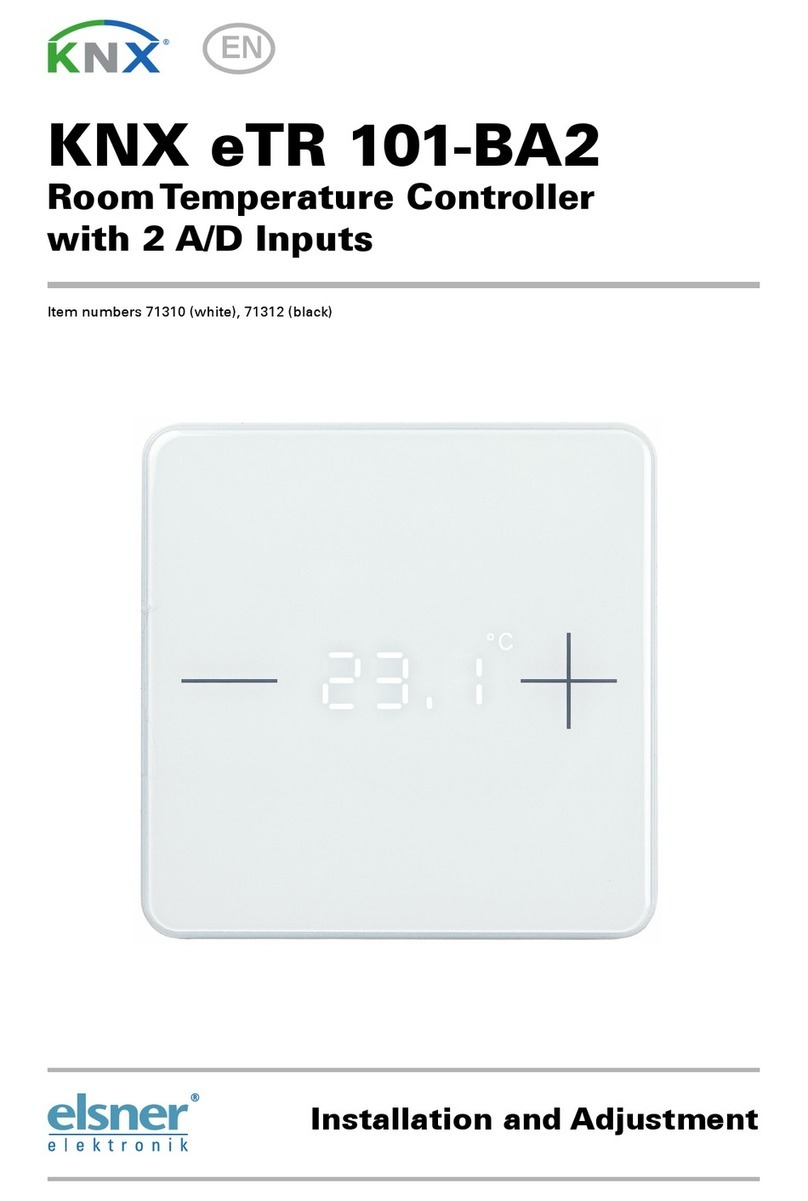
elsner elektronik
elsner elektronik KNX eTR 101-BA2 Guide
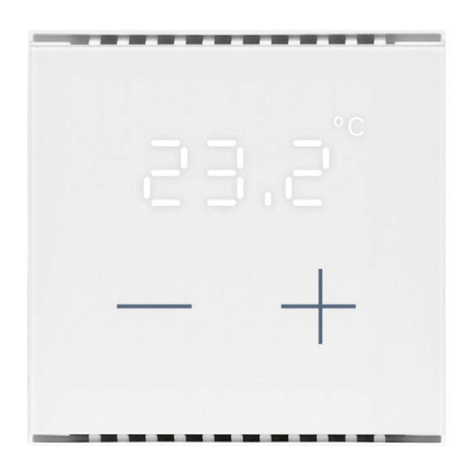
elsner elektronik
elsner elektronik Cala KNX T 101 User manual
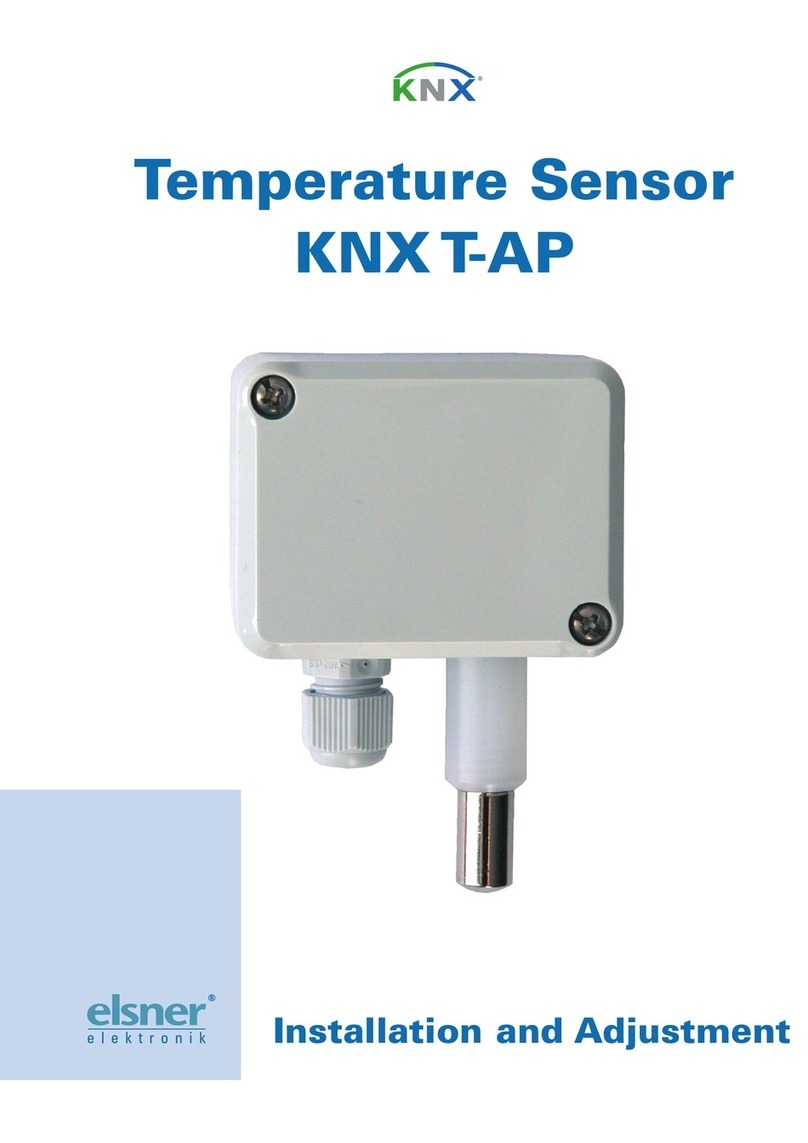
elsner elektronik
elsner elektronik KNX T-AP Guide
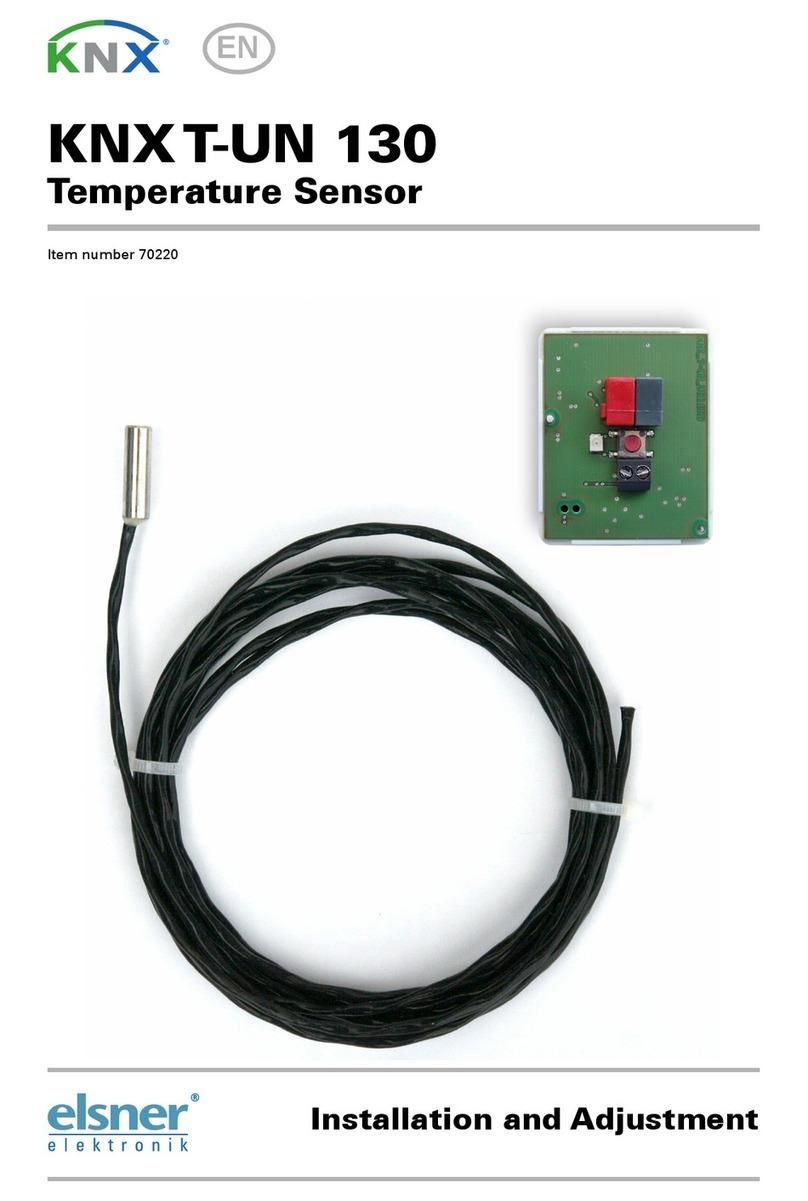
elsner elektronik
elsner elektronik KNX T-UN 130 Guide

elsner elektronik
elsner elektronik KNX eTR 201 Sunblind User manual
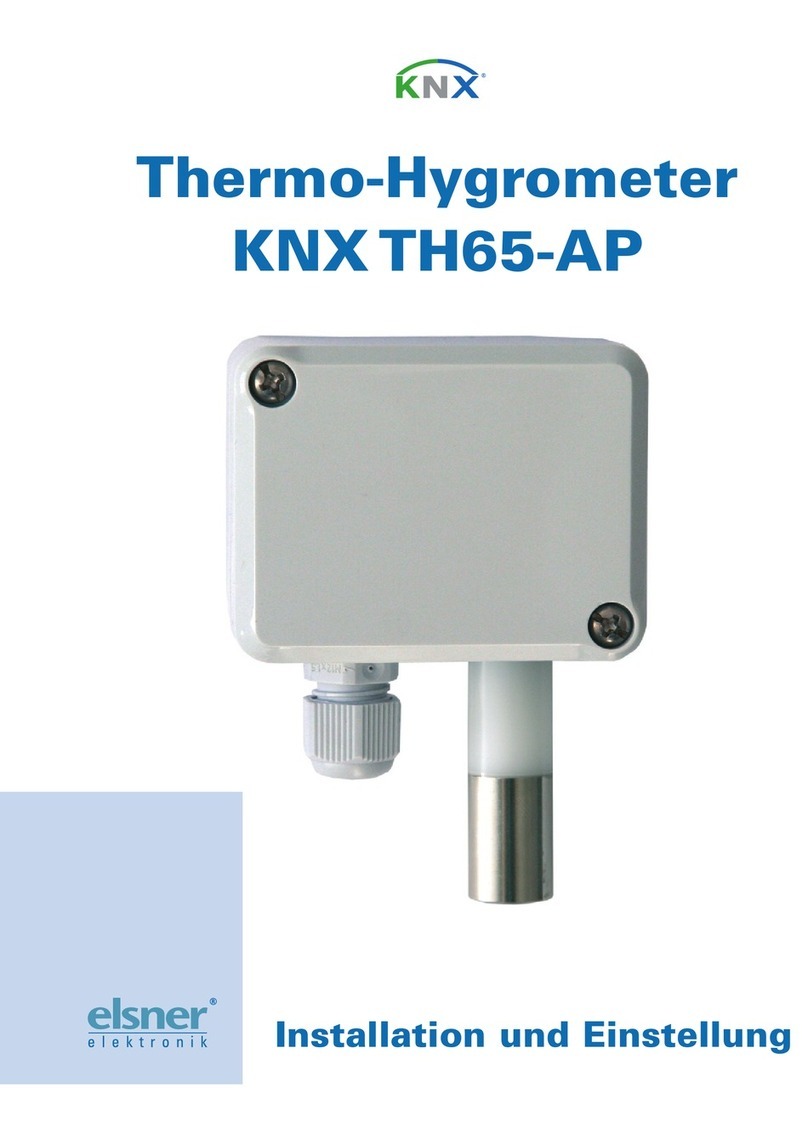
elsner elektronik
elsner elektronik KNX TH65-AP User manual

elsner elektronik
elsner elektronik Cala KNX T 101 User manual
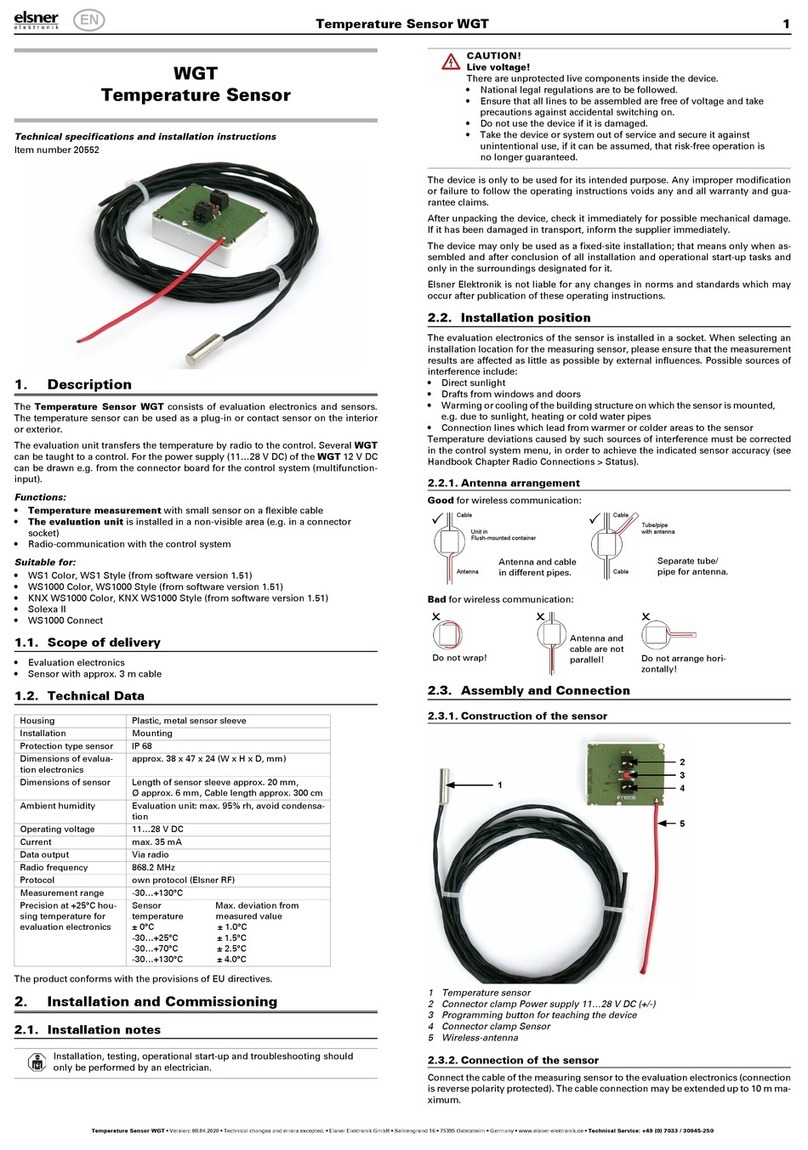
elsner elektronik
elsner elektronik 20552 User manual
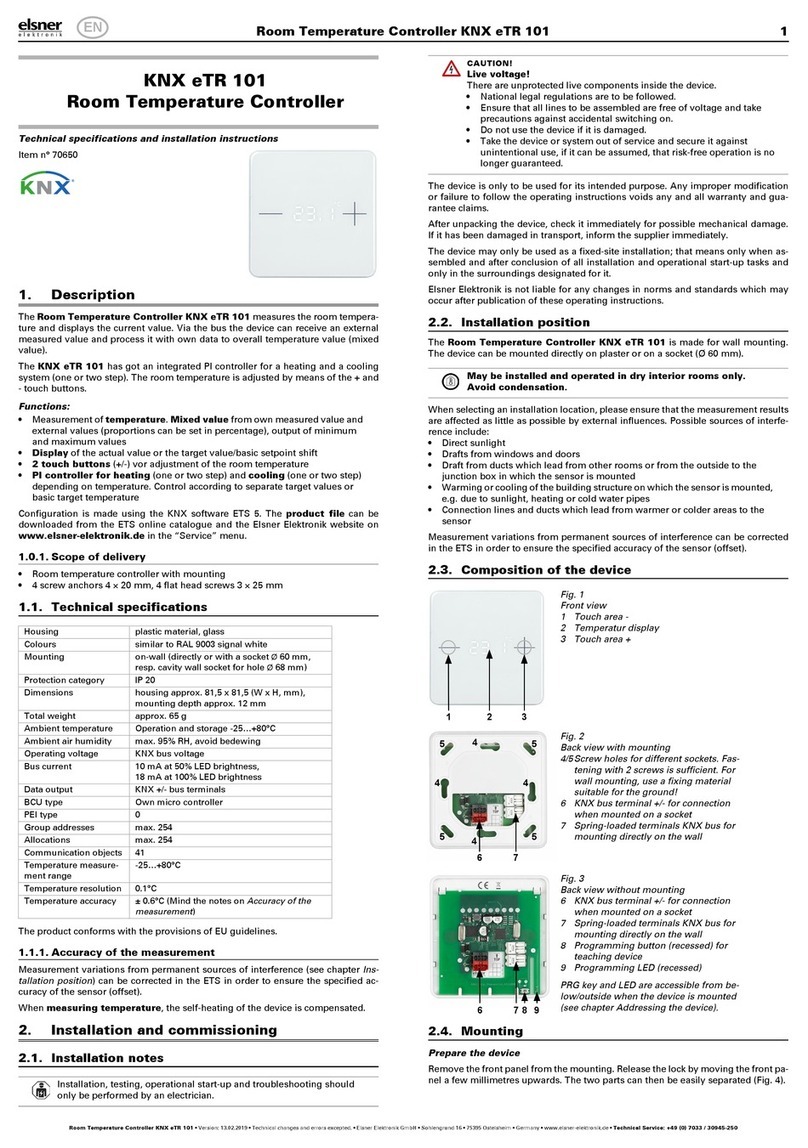
elsner elektronik
elsner elektronik KNX eTR 101 User manual

elsner elektronik
elsner elektronik Arexa 230V Window Control Guide
